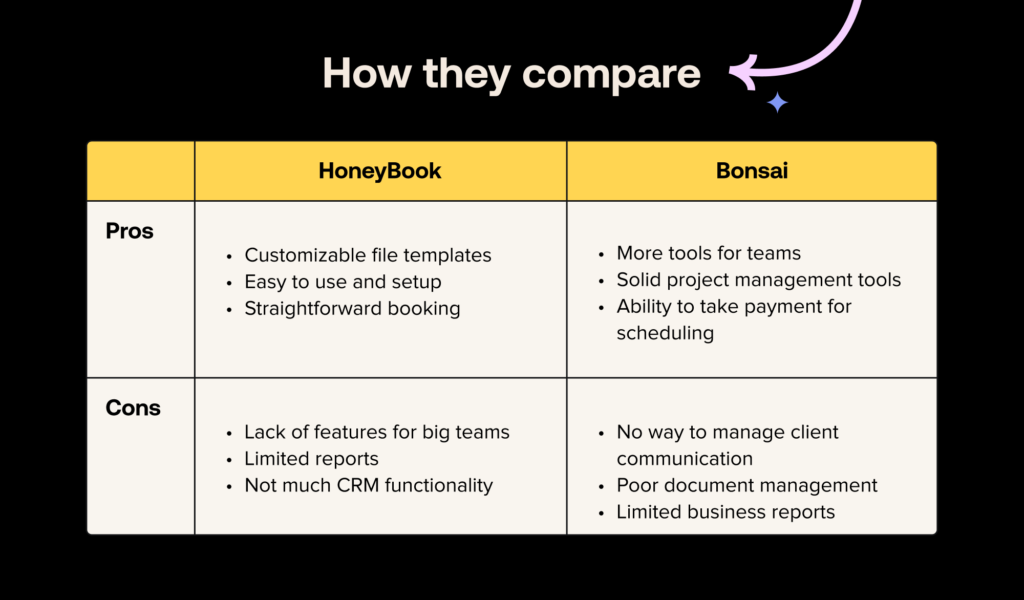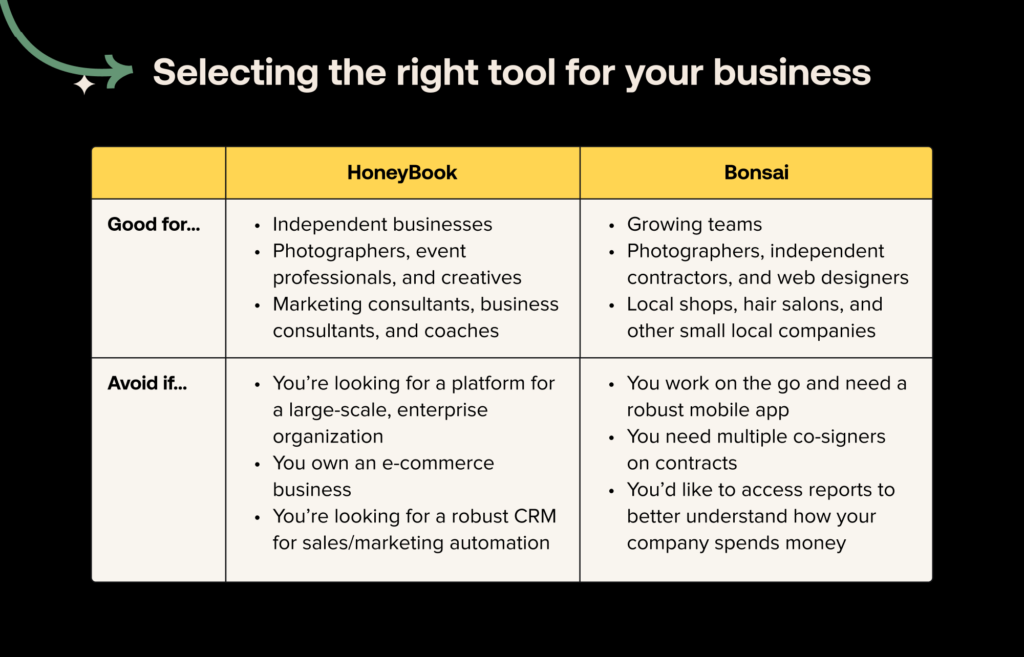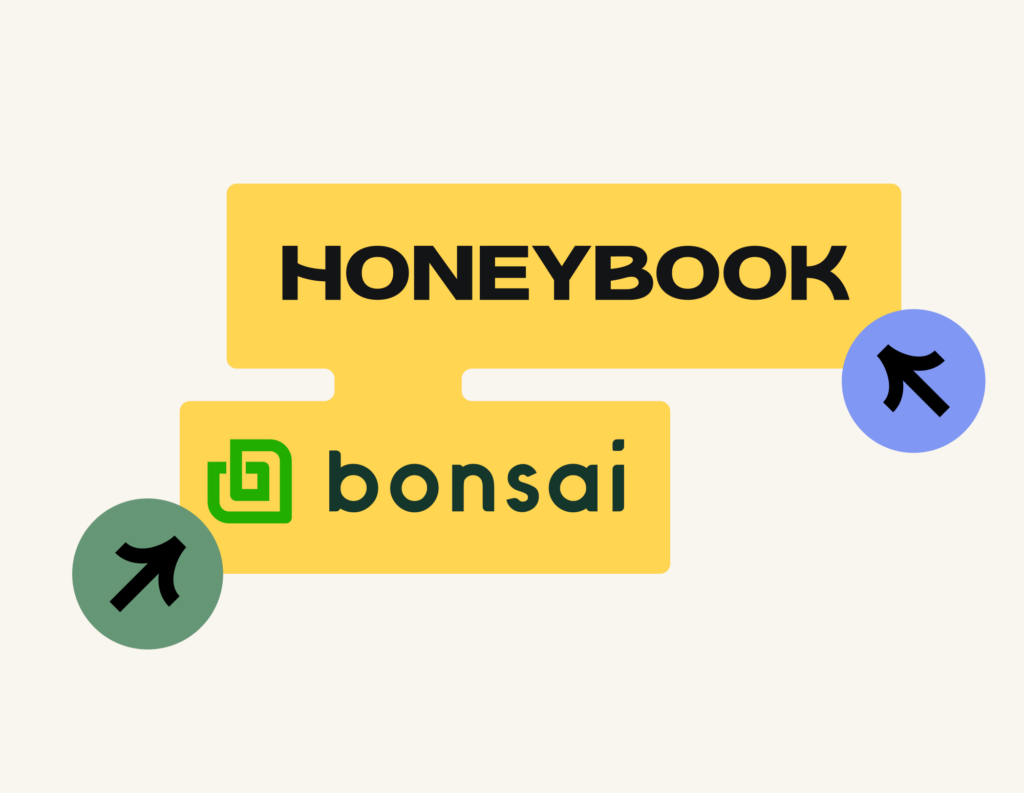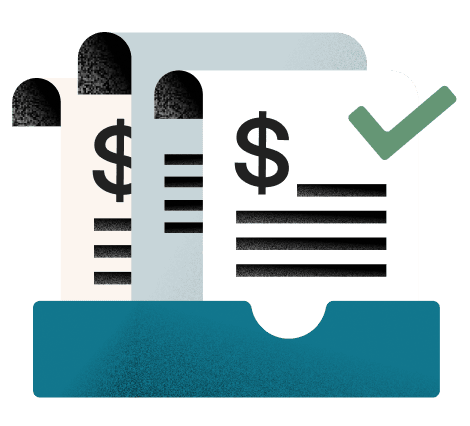Compare HoneyBook vs. Bonsai and see which business management platform is best for your needs.
HoneyBook and Bonsai are two names that come up often when it comes to all-in-one small business platforms. Both are very similar in offerings, but when it comes down to how they perform for different business needs, who wins out?
I spent time using both so I could properly summarize how they perform for lead management, invoicing, scheduling, client communication, and more. To save you time, jump to the different points you’re looking to compare and see which one wins out for your business.


Jump to:
- Lead management
- Invoicing
- Contracts
- Payments
- File templates
- Scheduling
- Client communication
- Project management
- Reporting
- Mobile app
- Integrations
- Customer support
- Pricing
- Summary
Lead management
Who wins out?
HoneyBook and Bonsai offer a lot of the same options for lead capture and management, including customizable forms. Neither offer great CRM capabilities to manage leads, but HoneyBook stands out with the ability to offer instant booking through lead forms.
HoneyBook
HoneyBook offers two options for capturing leads: a standard contact form and a more robust lead form. Both are customizable, but the HoneyBook contact form is a simple way to capture leads, while lead forms enable you to add additional actions, like scheduling a meeting and paying up front.
You can share both forms on your public channels or privately to capture interested leads. I especially like the fact that you can choose from templates or build from scratch and save multiple forms for different audiences.
Once leads inquire, HoneyBook captures them and adds them to your account and project pipeline. I’ve customized my pipeline to match the steps I use to move leads forward to booking, which makes lead management easier. Plus, I like that you can manage all your communication and files in one project workspace with leads and clients.
Another great feature is HoneyBook automations, which I’ve used to set up instant responses and guide leads through next steps, such as filing out a questionnaire, scheduling time, and booking.
HoneyBook does have it’s limitations with lead management. It doesn’t operate as a traditional CRM where you can score leads or nurture them and access other sales features like marketing automation. In my use, I think its lead management is great for independent businesses that don’t have a large volume of leads.
Bonsai
Bonsai offers contact form templates as well as the ability to make your own from scratch. I personally love choosing from the available templates, because they have a wide variety– from general client intake to forms specific to different business types. With any form, you’re able to customize the font, colors, and content blocks.
When your forms are ready, you can share them via email, public link, or an embed code for your website. Once any leads fill out your forms, they’re added to your Clients list in Bonsai where you can see their contact information, which forms they’ve filled out, and what projects they’re associated with.
You can also use automations once leads fill out your forms to schedule an event in Bonsai, schedule a meeting through Calendly, send another form, or send a message. The only thing about Bonsai forms is that there’s no way to allow leads to book immediately, which is useful if you need to accept payment before scheduling.
Invoicing
Who wins out?
HoneyBook offers invoice templates for different industries and the ability to customize and save your invoice templates, where Bonsai falls short.
HoneyBook
As soon as you create a HoneyBook account, you have access to invoice templates that are easy to customize and use–whether you need a general invoice or a version that’s built specifically for your company type.
Like HoneyBook’s other templates, you can edit your invoice templates or build from scratch using a drag-and-drop editor that supports text, video, and images. I was able to easily incorporate my company brand to make sure my invoices were personalized.
The best part about HoneyBook invoices is the ability to include other actions, like service selection, contract signing, file upload, questionnaires, and scheduling. With every invoice, HoneyBook includes integrated payment processing, so your clients don’t have to jump into another service to pay.
For instance, I can use an all-in-one booking file that includes my meeting scheduler, an invoice for the session, a contract, and payment processing.
Bonsai
Bonsai doesn’t offer invoice templates, but you can choose from a few different invoice types to create your own, including a single invoice, recurring invoice, subscription invoice, and bundled invoice.
From there, it’s easy to build your invoice with all of the details you want to present, but there aren’t many customization options to make sure the invoices are branded.
I also don’t love that there’s now way to save my own invoices as templates. I can duplicate invoices from other clients and projects, but it would save time to have set templates that I use for specific project types.
Clients are able to pay invoices via credit card, ACH bank transfer, as well as via PayPal integration, so I do like that there are a variety of options.
Contracts
Who wins out?
Both HoneyBook and Bonsai offer a wide variety of contract templates, but HoneyBook takes them a bit further with the ability to include smart fields and combine contracts with other files like invoices.
HoneyBook
HoneyBook offers attorney-reviewed contract templates that you can immediately update with your own information and start using with clients. Whether you need a general contract or a specific agreement (liability waiver, proof sign-off, model release, NDA, etc.), HoneyBook has several options to choose from.
As always, I was still able to start from scratch and drop in my own specific legalese that I wanted to use, but the templates are a really great start.
The contract templates include smart fields, which allowed me to dynamically populate client and project information, like client name, project name, and project date. I saw that you can also pull in information that you’ve set for your company, such as payment late fees and your company information.
I love that HoneyBook contract templates are accessible via desktop or mobile, allowing your clients to eSign from any device.
Bonsai
Bonsai offers a variety of contract templates that you can choose, including services agreements, statements of work, and contracts for specific industries like photography, accounting, and consulting.
You can customize your contracts to update the information, include your logo, and adjust the font, and can also save as a unique template. Bonsai contracts are enabled for esignature, and you can include one cosigner per contract.
Bonsai does allow you to require payment immediately after the contract is signed, but I do wish that it was easier to combine my invoices and contracts. One area where Bonsai contracts fell short was with dynamic fields–I haven’t found a way to incorporate smart fields for my client names, project names, or other information.
Payments
Who wins out?
It’s a toss up. Both HoneyBook and Bonsai offer the same payment options, with Bonsai including PayPal as an option. However, HoneyBook has slightly lower transaction fees. In the end, it depends whether fees or payment options matter more to you.
HoneyBook
With integrated payment processing in your invoice templates, HoneyBook makes it faster for you to get paid. In fact, 90% of HoneyBook invoices get paid on time.
Through HoneyBook, I accept credit card and ACH payments and enjoy some of the lowest transaction fees in the industry, starting at 2.9% + 25¢ for cardholder-entered payments. For reference, PayPal’s cardholder entered fees start at 2.99% + 49¢.
While the integrated payments are helpful for me, I could see that some may not like the inability to choose their own payment processor.
One thing I really love about HoneyBook is that you don’t have to chase payments. You can turn on automatic payment reminders and autopay, along with late payment fees for clients who pay past their due dates.
For greater organization, HoneyBook also enables you to track payment statuses in one place. Plus, view your profit and loss and get greater accounting insights with a seamless integration to Quickbooks.
Bonsai
Bonsai makes the payment process a relatively easy one. You can accept instant payments through your contract, and when you send a proposal, you can offer your potential clients an opportunity to pay a retainer to lock in your services.
Moreover, when you have a new client, you can even set up recurring billing if you offer a subscription-based business.
The platform offers a wide range of payment options, like credit cards and online checks, and processing fees were relatively consistent with the payments industry. On credit card payments, I was charged 2.9% plus a $0.30 fee per transaction, and digital check payments were charged a flat 1% fee.
File templates
Who wins out?
HoneyBook offers a bit more variety of template types, greater organization, and the ability to combine multiple actions into a template.
HoneyBook
File templates are one of HoneyBook’s strong suits. With an account, you already have a great starting point for every aspect of your clientflow: the process from capturing and qualifying leads to booking clients, managing projects, and maintaining relationships.
You can access all of the following templates, plus build your own:
- Lead forms
- Questionnaires
- Invoices
- Contracts
- Proposals
- Pricing and services guides
- Sales brochures
- Scheduling forms
- Welcome packets
- Project closure files
HoneyBook’s template gallery also offers a variety of templates that are specific to different industries, and are designed by business owners themselves.
Bonsai
Overall, Bonsai has a good variety of templates to choose from, including:
- Proposals
- Quotes
- Estimates
- Forms
- Contracts
Each template type includes options for many different business types, from marketing and design to coaching, photography, real estate, and more.
I’m able to customize most of the templates with simple edits, though I did find myself wishing there was more I could do in terms of combining different actions and making more robust files for clients.
Also, the way Bonsai organizes their templates is a bit confusing. There’s no single place to save all of the templates I’m using or organize them based on projects or clients. Instead, I have to go to each specific section of the platform to view the templates available.
Scheduling
Who wins out?
The HoneyBook and Bonsai schedulers are very similar, but Bonsai wins out by requiring payment before scheduling. Though you can do so with HoneyBook as well, it’s not as seamless.
HoneyBook
Inside your account, you can sync your Google, Microsoft, and Apple calendar. Once you integrate, you can see all of your meetings and appointments in one place, plus add team members to view their schedules in your calendar view as well.
With your calendar synced, you can present an accurate view of your availability within the HoneyBook scheduler. Just like other tools like Calendly, you can build specific session types, set your availability for each one, and send them to leads or clients with a link to book time with you.
Instead of going back and forth to find a time that works, clients can select an open time slot on your calendar. Unfortunately, I found it a bit limiting since you can’t offer group scheduling or rescheduling for clients on HoneyBook.
If you also require clients to pay before scheduling with you (say you’re a photographer or a consultant), you can do so with a lead form or a scheduling file template that includes invoice and payment.
Bonsai
When it comes to scheduling, you’ll need to integrate the Bonsai app with your calendar app if you want to take advantage of Bonsai’s scheduling tools. The platform offers seamless integration with leading calendar apps like Google Calendar and iCloud.
From there, you can create event types, set your availability, and require payment before booking. You can also turn on an automatic meeting reminder email.
There are a few different ways to brand your Bonsai scheduler as well, including a custom color scheme and ability to add your logo.
Client communication
Who wins out?
HoneyBook seamlessly integrates with your email provider, making it easy to manage all client communications in one place. Bonsai doesn’t offer the same option.
HoneyBook
With HoneyBook, I don’t have to worry about sifting through emails or missing client communication. You can integrate any email provider with your account so you’re able to see client emails inside your workspaces. The only downside is that you have to start an email thread in your HoneyBook account, so it won’t pull in all of your emails in your inbox.
From there, you can leverage HoneyBook email templates to save time, set up automated emails at key moments (like after a lead inquires), and even use HoneyBook’s AI Composer to quickly send messages to leads and clients that fit your tone and voice. I personally love setting up email automations for my inquiries to make sure I respond quickly and save time providing information to them.
Though I didn’t set one up, you also have the opportunity to create a branded client portal that clients can use to view communications and files in one place.
Bonsai
There is no inbox in the Bonsai platform whatsoever, which is is a big feature gap.
While the platform does make it easy to send automated messages and to automate much of client communications, including contracts, proposals, and more, it didn’t make sense that it didn’t provide an inbox for easy client communications either from a top-level view or from an in-project view.
You can create a client portal to enable clients to view documents and project links, but communication isn’t stored there either.
Project management
Who wins out?
Though neither tools are designed for robust project management, Bonsai offers a bit more features for visual project management and team management as well as more.
HoneyBook
After using the platform, you can tell that HoneyBook isn’t focused on project management. But, it does provide some project management tools.
The project pipeline is fully customizable and can be automated, so you can seamlessly move clients and project statuses forward without having to manually keep track. Only you can see your project pipeline though, so I didn’t see a way to share statuses with clients.
I terms of tasks, you can track them in HoneyBook, associate them with specific projects, and assign them to your team members. Within automations, you’re able to set up task reminders so you never miss a deadline, which I find helpful for staying on top of project deliverables.
As you’re working on projects, you can use your project workspace or client workspace to stay on top of communications, files, notes, and information associated with that specific project or client.
Bonsai
Bonsai offers a wide range of project management tools, from project workspaces to task management and team management.
I use the task tracker in Bonsai often because it offers a list view as well as a Kanban board view, and I like having the visual option to see what status all of my tasks are in.
The platform also proved effective for projects I was collaborating on with others. Assigning collaborators to projects was a relatively simple process and it was easy to manage time tracking and progress among those collaborators.
One unique feature that Bonsai includes is its Resourcing feature, which enables you to allocate specific projects to team members, including the timeline and amount of hours they’ll be working on each. You can also use a timer to track your hours worked for different projects and view timesheets for different team members.
Reporting
Who wins out?
HoneyBook and Bonsai differ in the reports they offer. While Bonsai offers more reports on project management, HoneyBook offers more reports based on financial and business performance. In the end, HoneyBook’s reports are a bit more helpful for business owners.
HoneyBook
HoneyBook offers several reports to provide insights on things like:
- Monthly bookings
- Booking rate
- Collected payments
- Outstanding payments
- Refunded payments
- Lead sources
Though you can select a specific time frame to view each report, it is a bit limiting that you can’t customize any of the reports.
Premium HoneyBook users can also access team member and client reports.
Bonsai
Bonsai has some reporting based on your finances, but a lot of its reports are actually based on project management.
On the financial side, you can keep tabs on your team, client, and project profitability, and you have the abilty to look at your project profitability forecast.
On the project mangement site, Bonsai tells you about your activity, team utilization, project health, and task completion.
While the reports are helpful, I do find myself wishing I had more standard business reports like cash flow and profit and loss.
Mobile app
Who wins out?
Neither HoneyBook nor Bonsai’s mobile apps are standout options, but HoneyBook offers a bit more in theirs for full-scope business management on the go.
HoneyBook
Within the HoneyBook mobile app, you can view your project pipeline to see statuses at a glance, plus view and edit your task list. You’re also able to manage your calendar and share your scheduler link along with other client communication, like sending and editing files.
Though you can customize your notifications, you have the option to get notified when you have a new message, when a client views a file, when someone signs a contract or pays an invoice, and when you have a task coming up.
Another great feature of the mobile app is time tracking. If you price your services by the hour, the time tracker enables you to stay on top of your working hours, then easily create an invoice directly from your tracked time.
Though the app is robust, I find it to be more of a companion to the desktop site since it doesn’t offer all of the same capabilities.
Bonsai
Bonsai does have a mobile app, but it leaves quite a bit to be desired. The app is a significantly condensed version of its full-fledged online tool. While you can pull reports and see basic progress information about your current clients on the mobile app, the process for creating new projects or getting any real detailed data on the mobile app seemed counterintuitive.
To me, the mobile app seems to be more for tracking the basics of existing clients and projects than for all-around, on-the-go business management. Nonetheless, the mobile app does exist and it can be useful in some instances.
Integrations
Who wins out?
Though they offer similar integrations, HoneyBook offers a bit more options for direct integration.
HoneyBook
HoneyBook offers the following integrations:
- Email and calendar (multiple platforms): Integrate your Gmail, Outlook, iCloud, or other email provider to centralize your client communication and calendar.
- QuickBooks: Sync your income information from HoneyBook into QuickBooks for more comprehensive online accounting (only one-way sync from HoneyBook to QuickBooks).
- Calendly: Integrate with Calendly to sync Calendly meetings onto your HoneyBook calendar or pull information from your HoneyBook calendar into Calendly.
- Facebook: Integrate with Facebook Lead Ads so you can populate your new leads directly into HoneyBook.
- Pic-Time: If you’re a photographer, you can use the Pic-Time integration to create new galleries, connect existing ones, and see the status of connected galleries all from HoneyBook.
- Zapier: Use Zapier to automate more with your favorite tools, like Trello, Asana, Clickup, Google Drive, and more.
Bonsai
Bonsai offers some integrations, but the list is relatively slim. However, I will say that I found options to integrate most of the tools I use as a freelancer and small business. With the Zapier integration in particular, you can connect with most popular platforms for business owners.
Bonsai offers integrations with the following apps:
- Gmail and Google Calendar
- Slack
- QuickBooks
- Calendly
- Google Drive
- Zapier, which facilitates integrations with additional platforms like Clickup, Trello, Xero, and more
Customer support
Who wins out?
HoneyBook and Bonsai offer similar support options in the form of chat or email Monday through Friday. However, HoneyBook offers a bit more with file setup, community support, and webinars.
HoneyBook
When you’re first getting started with HoneyBook you can access their free file setup service, which migrates existing files like your pricing lists, contract language, client questionnaires, and more. Within 72 hours, you’ll have your templates successfully added to your HoneyBook account, all without lifting a finger.
HoneyBook offers live chat and email support seven days a week from 7 a.m. to 7 p.m. PT, along with an AI chat resource that can help answer questions easily and quickly.
You can also leverage HoneyBook’s self-service resources like its Help Center and live and on-demand webinars.
A great benefit of HoneyBook is that it offers one-on-one dispute resolution, so you’re in good hands if you’re faced with a client chargeback. If you receive a dispute, a HoneyBook Dispute Specialist will work with you to collect evidence and respond to your band on your behalf.
HoneyBook doesn’t offer any phone support, except for billing issues and dispute resolution.
Bonsai
Bonsai offers customer support that you can get in touch with via chat in the app or by emailing [email protected]. The support staff is available 24 hours per day, Monday through Friday. However, there is no support offered on weekends.
It’s also worth noting that if you would rather troubleshoot on your own, you can also use the company’s help center. The help center offers a wide range of answers to questions that the company has received along the way. There are over a hundred articles in the Bonsai help center that can guide you through just about any conundrum you might face when using the platform.
Pricing
Who wins out?
HoneyBook offers more value for the price. While Bonsai has a lower starting cost, key features like branding removal and automations require higher tiers. HoneyBook includes essential tools like proposals, contracts, and payment processing at every level, making it the better all-in-one solution.
HoneyBook
| Starter | Essentials | Premium |
| $29/mo billed annually | $49/mo billed annually | $109/mo billed annually |
| – Unlimited clients and projects – Invoices and payments – Proposals and contracts – Calendar – All professional templates – Client portal – Basic reports | – Scheduler – Automations – QuickBooks Online integration – Up to 2 team members – Expense management – Profit and loss – Remove Powered by HoneyBook – Standard reports | – Unlimited team members – Priority support – Multiple companies – Onboarding specialist – Advanced reports |
Bonsai
| Starter | Professional | Business | Scale |
| $21/mo billed annually | $32/mo billed annually | $66/mo billed annually | Custom pricing |
| – Access to all templates – Unlimited clients and projects – Invoicing and payments – Contracts and proposals – Scheduling – Tasks and time tracking – Client CRM – Forms and questionnaires – Expense tracking | – Remove Bonsai branding – Workflow automations – Branded client portal – Unlimited scheduling events – QuickBooks integration – Calendly integration – Zapier integration | – Resource planning & scheduling – Utilization & capacity – Profitability & productivity reporting – Subcontractor management – Custom task fields – Premium customer support | – Custom roles – Custom data import – Dedicated onboarding – Assisted account setup – Dedicated support – Advanced integrations |
Summary
When comparing HoneyBook vs. Bonsai, HoneyBook wins on more points than Bonsai does. Overall, HoneyBook seems to offer greater customization, more options, more organization within the platform, and better business insights. And, HoneyBook even has a lower starting price than Bonsai.
Ultimately, the best choice depends on your specific business needs, so I recommend comparing each on the features that matter most to you.
Pros and cons
| HoneyBook | Bonsai | |
| Pros | – Highly customizable file templates for every step of your clientflow – Designed for ease of use and simple setup (file migration included) – Strong booking features for invoicing, contracts, and payments | – More tools specific to managing teams – Solid project management tools for small businesses – Ability to take payment for scheduling |
| Cons | – Lack of robust features for big teams – Limited reports – Not much traditional CRM functionality for sales or lead nurturing | – No way to manage client communication in the platform – Poor document and template management – Limited business reports |






